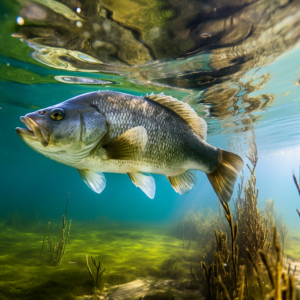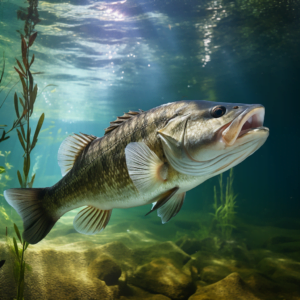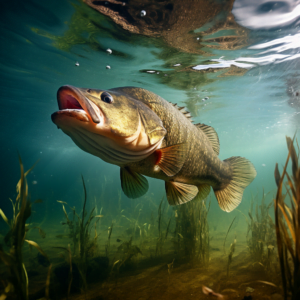Have you ever wondered how old a 22-inch largemouth bass is? It’s a fascinating question, isn’t it? Well, today we’re going to dive into the topic and uncover the age of these impressive fish. So, get ready to learn more about the age of a 22-inch largemouth bass.
Now, when it comes to determining the age of a fish, there are a few different methods scientists use. One common method is by examining the fish’s otoliths, which are small calcium carbonate structures found in their ears. By analyzing the growth rings in the otoliths, scientists can estimate the age of the fish. However, it’s important to note that this method is not always 100% accurate.
But, going back to our original question, how old is a 22-inch largemouth bass? Well, it can vary depending on a few factors such as the location and the overall well-being of the fish. On average, a largemouth bass grows about 0.9 inches per year. So, if we do the math, a 22-inch largemouth bass would be approximately 24 years old.
Introduction
Understanding the age of a largemouth bass
When you catch a 22-inch largemouth bass, have you ever wondered how old it is? The age of a fish can provide valuable information about its life history and can help us better understand its growth patterns and behavior. Largemouth bass (Micropterus salmoides) are one of the most popular sport fishes in North America, and their age can give us insights into their growth rate and habitat preferences.
Significance of a 22-inch largemouth bass
A 22-inch largemouth bass is a significant achievement for many anglers. It represents a trophy-sized fish and is often considered a benchmark for a successful fishing trip. However, the age of such a fish can vary greatly, depending on various factors such as habitat conditions, food availability, and fishing pressure. In this article, we will explore the growth rate and age estimation techniques for largemouth bass, with a particular focus on 22-inch individuals.
Growth Rate of Largemouth Bass
Factors influencing growth
The growth rate of largemouth bass is influenced by several factors, including genetics, food availability, water temperature, and competition for resources. Certain genetic traits can predispose some bass to grow faster and reach larger sizes at a younger age. Additionally, a healthy and abundant food supply is crucial for optimal growth.
Growth pattern and stages
Largemouth bass go through distinct growth stages during their lifetime. They start as larvae, then become fry, followed by the fingerling stage. As they mature, they enter the juvenile stage and eventually reach adulthood. Growth is most rapid during the first few years of life, with growth rates declining as fish get older.
Analyzing growth rings
One commonly used method to estimate the age of largemouth bass is by analyzing growth rings or annuli present in their scales or otoliths, which are small bone-like structures in their inner ears. Each annulus represents one year of growth, similar to the growth rings found in tree trunks. By counting the number of annuli, scientists can estimate the age of a fish.
Estimating Age of Largemouth Bass
Length-weight relationship
The length-weight relationship is another technique used to estimate the age of largemouth bass. By comparing the length and weight of a fish to established growth curves, scientists can estimate its age. This method is less precise than analyzing growth rings but provides a quick estimation in the field.
Age estimation techniques
In addition to analyzing growth rings and using the length-weight relationship, scientists use other techniques to estimate the age of largemouth bass. These include the examination of scale and otolith microstructure and the analysis of chemical elements within the fish’s body. Each method has its advantages and limitations and is often used in combination to obtain more accurate age estimates.
Comparison with similar species
To validate age estimation techniques, researchers often compare the age of largemouth bass with that of closely related species, such as smallmouth bass and spotted bass. These comparisons help ensure that the age estimates are consistent and reliable across different populations and habitats.
Research Findings
Studies on bass growth and age
Several studies have been conducted to investigate the growth and age of largemouth bass populations. These studies have provided valuable insights into the factors affecting their growth rates, such as food availability, habitat quality, and population density. They have also helped establish baseline data on the age structure of largemouth bass populations in various regions.
Size-aging correlation
Research findings have shown that there is a correlation between the size and age of largemouth bass. While it is not always accurate to estimate the age of a fish solely based on its size, larger fish tend to be older than smaller ones. This correlation varies among populations and can be influenced by environmental conditions and genetic factors.
22-Inch Largemouth Bass
Characteristics of a 22-inch bass
A 22-inch largemouth bass is considered a trophy-sized fish and is highly sought after by anglers. At this size, the bass is typically well-nourished, muscular, and in prime condition. Its coloration may be more vibrant, with dark green sides and a pale belly. These larger individuals often exhibit a deeper body profile, giving them a stout appearance.
Size-age relationship
The age of a 22-inch largemouth bass can vary considerably depending on several factors. On average, a bass of this size can be anywhere from 5 to 10 years old. However, exceptional individuals might reach this size at a younger age. Factors such as genetic predisposition, favorable habitat conditions, and available food resources can influence the rate of growth and age at which a bass reaches 22 inches.
Factors affecting size at specific age
The size at which a largemouth bass reaches 22 inches can be influenced by a variety of factors. A combination of genetics, environmental conditions, and food availability can determine the growth potential of an individual bass. Fish living in nutrient-rich lakes or ponds with abundant prey items may have a higher chance of reaching this size at a younger age compared to those in less productive habitats.
Habitat and Environmental Factors
Impact of habitat on bass growth
Habitat plays a crucial role in the growth and development of largemouth bass. They are most commonly found in freshwater habitats such as lakes, ponds, reservoirs, and slow-moving rivers. Factors such as water quality, vegetation cover, and the presence of underwater structures play a significant role in providing suitable habitat for bass to thrive and grow.
Role of water temperature
Water temperature is a key environmental factor influencing the growth rate of largemouth bass. They are ectothermic animals, meaning that their body temperature is regulated by the surrounding water. Bass tend to have a higher growth rate in warmer waters, as their metabolism and feeding activity increase. Conversely, colder water temperatures can slow down their growth.
Availability of prey
The availability of prey items also directly impacts the growth rate and size of largemouth bass. They are opportunistic predators and consume a variety of prey, including smaller fish, crayfish, frogs, and insects. In habitats with abundant prey resources, bass have a higher chance of reaching larger sizes at a younger age. The availability and quality of forage species can vary among different lakes and rivers.
Human Impacts
Fishing pressure
Fishing pressure can have a significant impact on the age structure and size distribution of largemouth bass populations. Overfishing, particularly targeting larger individuals, can disrupt the balance between different age classes, leading to imbalanced population dynamics. Conservation measures such as catch-and-release practices and size limits can help mitigate the effects of fishing pressure.
Habitat destruction
The destruction and degradation of aquatic habitats can negatively impact largemouth bass populations. Activities such as urban development, agricultural runoff, and dredging can destroy important spawning areas, reduce food availability, and degrade water quality. Protecting and restoring essential habitats is crucial for maintaining healthy and sustainable largemouth bass populations.
Pollution’s influence on growth
Pollution, including chemicals, heavy metals, and excess nutrients, can also affect the growth and development of largemouth bass. Water pollution can disrupt their hormonal balance, impair their immune system, and lead to decreased growth rates. It is essential to reduce pollution and promote clean water initiatives to ensure the long-term health of bass populations.
Conservation Measures
Sustainable fishing practices
To conserve largemouth bass populations, sustainable fishing practices should be implemented. This includes following catch limits, practicing catch-and-release with care, and avoiding excessive fishing pressure on vulnerable age groups. By practicing responsible angling, anglers can contribute to the long-term sustainability of largemouth bass populations.
Creating and preserving habitats
Creating and preserving suitable habitats for largemouth bass is crucial for their survival and growth. This can involve establishing fish attractors such as submerged vegetation, fallen trees, and artificial structures like brush piles and rock reefs. Protecting wetlands and conserving natural shoreline vegetation also helps maintain water quality and provide critical habitat for bass.
Education and awareness programs
Education and awareness programs play a vital role in promoting the conservation of largemouth bass and their habitats. Through public outreach, anglers and the general public can learn about responsible fishing practices, the importance of habitat preservation, and the need to protect water quality. Engaging communities and fostering a sense of stewardship is crucial for the long-term sustainability of largemouth bass populations.
Recreational Fishing and Management
Regulations and restrictions
Regulations and restrictions are put in place to manage recreational fishing for largemouth bass. These include size and bag limits, closed seasons, and special regulations for certain areas or bodies of water. Compliance with these regulations ensures that fishing pressure is managed sustainably and allows bass populations to thrive.
Catch-and-release practices
Catch-and-release practices are widely encouraged among recreational anglers to promote the conservation of largemouth bass. Releasing fish unharmed, using proper handling techniques, and minimizing the time the fish spends out of the water are essential for a successful release. This practice allows bass to continue growing and reproducing, contributing to the stability of their populations.
Monitoring and fishery management
Monitoring largemouth bass populations through regular surveys and data collection is critical for effective fishery management. By collecting information on population size, age structure, and growth rates, fisheries managers can make informed decisions to maintain healthy populations. This includes adjusting regulations, implementing stocking programs, and improving habitat conditions when necessary.
Conclusion
Summary of findings
In summary, the age of a 22-inch largemouth bass can range from 5 to 10 years, depending on various factors such as habitat conditions, genetics, and food availability. Analyzing growth rings and using the length-weight relationship are common techniques for estimating the age of largemouth bass. These age estimates provide valuable insights into the growth patterns and life history of this popular fish species.
Appreciating the age of a 22-inch largemouth bass
Catching a 22-inch largemouth bass is an achievement to be proud of, but understanding its age adds another layer of appreciation. Each bass represents years of growth, survival, and adaptation to its environment. Appreciating the age of these fish reminds us of the importance of conservation and responsible fishing practices to ensure their continued existence.
Ensuring conservation for future generations
Conserving largemouth bass populations is not only beneficial for anglers and recreational fishing but for the overall health of aquatic ecosystems. By implementing sustainable fishing practices, protecting and restoring habitats, and raising awareness about the importance of conservation, we can ensure that future generations will have the opportunity to enjoy the thrill of catching a 22-inch largemouth bass. Let’s do our part to safeguard these remarkable fish for years to come.




